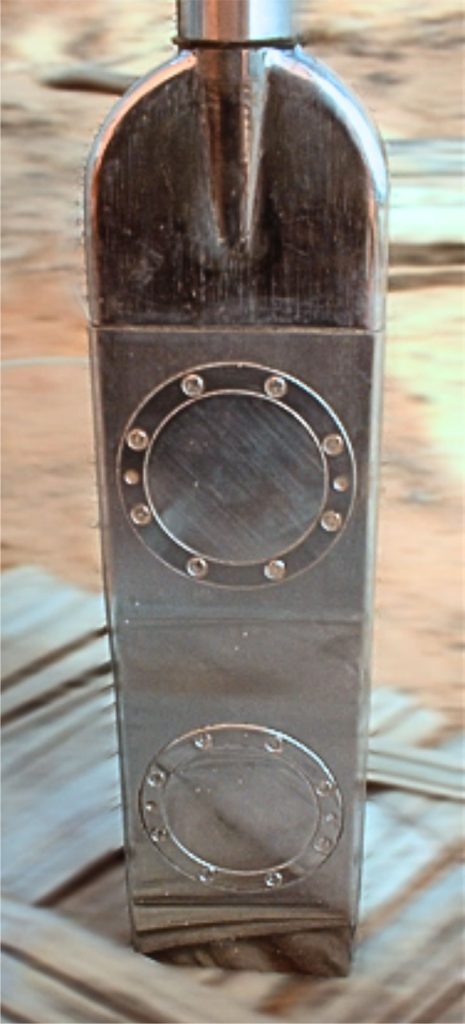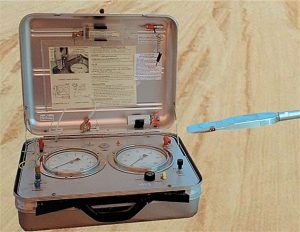INSTRUMENTATION DEVELOPMENT UNPAR-DUAL FLAT DILATOMETER TEST (UNPAR-DDMT) FOR IN-SITU STRESS AND SOIL MODULUS RESEARCH
Research Team : Yunan Halim, ST., MT., Prof. Dr. Ir. Paulus P. Rahardjo, MSCE., Ir. Wisjnu Brotodihardjo, MSCE.
Year : 2003
Abstract : Flat Dilatometer Test (DMT) which firstly developed by Silvano Marchetti (1980) in Italia was a series of tester designed to gained soil stress and modulus using a stainless steel blade with a thin flat circular expandable steel membrane on one side. In the recent development, DMT can be used to gain soil parameters such as soil stratification, Lateral stress coefficient, overconsolidation ratio, undrained shear strength, constrained modulus and so on that generally obtain from empirical correlation.
Unlike Marchetti flat dilatometer (MDMT), which is 95 mm wide and 15 mm thick with one flexible membrane on one side, Handy (1982) developed blade with 75 mm wide and four thickness steps, 3 mm, 4.5 mm, 6 mm and 7.5 mm, where each step has pressure cell. Blade thickness difference is meant to measure soil pressure (horizontal stress, σh) directly without correlation. Handy named his device as K-Stepped Blade Test (K-SBT). Basic idea of Marchetti and Handy inspired writer two designed and created instrument called UNPAR-Dual Flat Dilatometer Test (UNPAR-DDMT) with 95 mm wide and two steps thickness, 15 mm and 30 mm.
The UNPAR-DDMT research was located in Dumai Industrial Estate (KID), Desa Pelintung, Riau at peat and clay soil layers. Beside UNPAR-DDMT testing, MDMT, CPT and drilling were also taken place at KID where all those results will be used as a comparison to UNPAR-DDMT.
UNPAR-DDMT testing shows material index (ID) with 30 mm thickness blade is closer to coring than interpretation from MDMT blade. It also helps to differentiate between clay and peat using equivalent of effective horizontal stress, (po – u0). If (po – u0) is smaller than 0.6 bar, it is indication of peat soil and if it is bigger than 0.6 bar so it tends to be clay soil.
Interpretation of undrained shear strength (su) from several empirical correlation in study location will be given more convergent results if using 30 mm thickness blade. If it compare to Triaxial-UU, Larsson and Eskilson, 1989 gives nearest result. In soft clay layer, su results 1-1.2 t/m² in average and over consolidation ratio (OCR) 0.5-1. While in peat is much more variety with OCR 0-3.1. Soil lateral stress coefficient, K0, gained in clay layer varies from 0.3-0.7 with 30 mm blade, while in peat layer is much more variety from -0.1 – 1.2.
From comparison between dilatometer modulus, ED in 30 mm thickness blade and constraint modulus (M) comparison from oedometer test, gives an average relationship M = {0.7 e^(0.015)^σ’v} × ED. Effective preconsolidation stress, σ’p interpretation with Kulhawy & Mayne, 1990 relationship for 15 mm and 30 mm blade thickness gives identical result with oedometer test. σ’p value gained in clay layer is 2.5 – 5 t/m² and 1.2 – 2.5 t/m² for peat layer. From UNPAR-DDMT with 30 mm blade thickness testing in clay, writer discover the correlation of thrust (ΔσDDMT) and equivalent of effective horizontal stress, (po – u0) with ΔσDDMT = 4.5 (po – u0) and Δp with relationship σDDMT = 10(Δp) + 0.7 for σDDMT > 9 Bar.



